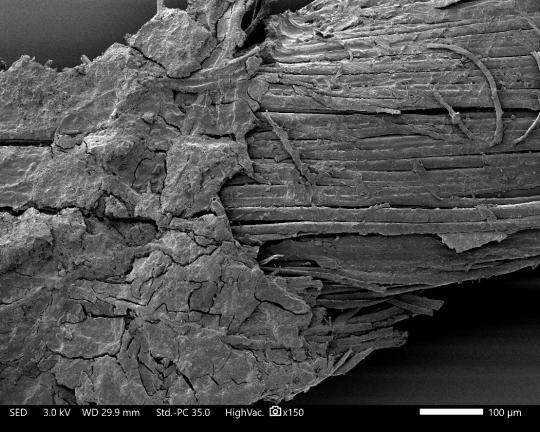Bioeconomy Reading time 3 min
Studying the fabrics of the past to understand the ageing of the eco-materials of the future
Published on 15 November 2021

"San Cristoforo", by Giulio Benso (1592-1668), oil on canvas 74x90 cm (inv. 162) from the collection of Professor Antonio Ceci (1920).
The use of renewable plant resources, such as flax fibres, to design durable materials is an essential milestone in the transition to a bioeconomy based on the rational use of biomass. However, these new eco-materials are often confronted with mistrust about their strength and durability compared to materials derived from petroleum resources. The study of extreme ageing poses time-scale problems for scientists who are often forced to resort to artificially accelerating processes in the laboratory, at the risk of deviating from reality. Flax is a plant that has been cultivated and used to make various objects for thousands of years and in particular to make canvas. This is why the research team studied the canvases of four paintings from the Baroque period, dated between the 17th and 18th centuries and exhibited in the Civic Art Gallery of Ascoli Piceno in Italy, and whose conservation methods had been traced. This work complements the one published in September in Nature Plants on the analysis of 4000-year-old Egyptian mortuary linen, by the same French team in collaboration with the Louvre Museum, FEMTO-ST (Besançon), LMGC (Montpellier) and the University of Cambridge.
Analytical methods that preserve the integrity of the paintings
One of the challenges of this study was the constraints related to the collection and analysis of samples that had to preserve the historical paintings, as any sample obtained from a heritage object must be returned. 4 cm² were taken from the back of each canvas in areas that were not visible and that did not degrade the work. Subsequently, the researchers used several very high-resolution optical analysis methods to study the fibre structure of the samples without degrading them. They used atomic force microscopy[1] to map the surface of the samples as well as the stiffness of the fibres at the nanoscale. They also used two-photon microscopy [2], NMR spectroscopy [3] and infrared spectroscopy [4] to analyse the organisation, biochemical evolution and structure of the flax fibres composing the fabrics.

Environmental variations: the main factor in ageing
Counter-intuitively, the results show that fibres from fabrics a few hundred years old have undergone more marked degradation than those from thousand-year-old Egyptian mortuary linens. A general stiffness was found in almost all the ancient fibres compared to a modern linen yarn. However, the yarns in the paintings also showed other structural defects such as fibre fragmentation due to oxidation, as well as fungal attacks that severely degraded the fibre structure by forming "tunnels" and fractures in the fibres.
In terms of ageing, the fibres of the paintings have been under constant tension, but they have also been exposed to variations in humidity and temperature as well as to air pollution during their exhibition in churches or private collections before their acquisition by the Civic Art Gallery. In addition to these factors, the effects of other ageing agents such as glue, plaster and paint can make them more similar to new generation objects such as composites, in which several materials coexist - often of a very different nature - to form a new material combining and improving the properties of the original materials. The scientists have shown that certain conservation techniques applied in the 19th century, such as lining with glue paste, made from flour and animal glue, have contributed to the long-term degradation of the paintings. In the end, the paintings that have undergone the most variations in their environment or that have undergone treatments during their conservation are the most degraded.
This work provides valuable information on the behaviour and performance evolution of natural fibres. It is both useful for the design of robust eco-materials that will last over time, but also provides valuable information on the state of conservation of historical objects. While this work focuses on flax, the method is also applicable to other fibres used throughout history, including hemp, used for rope and ship sails. The team is now studying flax textiles from other periods and origins. In 2022, the French National Research Agency (ANR) ANUBIS project will commence, led by IRDL in collaboration with the SOLEIL Synchrotron, the University of Cambridge, the Egyptian Museum in Cairo and INRAE.
[1] Atomic force microscopy is based on scanning the surface of a sample to be analysed with a very fine tip a few micrometres in diameter. After extensive computer processing of the signal, it is possible to establish the topography of the sample.
[2] Two photon microscopy is an optical imaging technique that combines fluorescence to image samples non-destructively to a depth of about one millimetre. It allows the visualization of the structure and internal orientation of the cellulose chains that provide the tensile strength of flax fibres.
[3] NMR spectroscopy is based on nuclear magnetic resonance, a property of certain atomic nuclei to release energy, i.e. relax, after being subjected to electromagnetic radiation. The relaxation signature recovered corresponds to a very precise frequency, which can be used, under certain conditions, to describe the composition and state of organisation of the molecules in a sample.
[4] Infrared spectroscopy is a non-destructive method that operates in the infrared region of the electromagnetic spectrum. This technique is used for the indirect identification of the chemical composition of a sample.
References
- Alessia Melelli, Graziella Roselli, Noemi Proietti, Alain Bourmaud, Olivier Arnould, Frédéric Jamme, Johnny Beaugrand, Alice Migliori, Giuseppe Di Girolami, Paolo Cinaglia, Carlo Santulli. Chemical, morphological and mechanical study of the ageing of textile flax fibres from 17th/18th-century paintings on canvas. Journal of Cultural Heritage, 2021. https://doi.org/10.1016/j.culher.2021.10.003
- Alessia Melelli, Darshil U. Shah, Gemala Hapsari, Roberta Cortopassi, Sylvie Durand, Olivier Arnould, Vincent Placet, Dominique Benazeth, Johnny Beaugrand, Frédéric Jamme & Alain Bourmaud. Lessons on textile history and fibre durability from a 4,000-year-old Egyptian flax yarn. Nature Plants, 2021, 7, 1200–1206. https://doi.org/10.1038/s41477-021-00998-8
